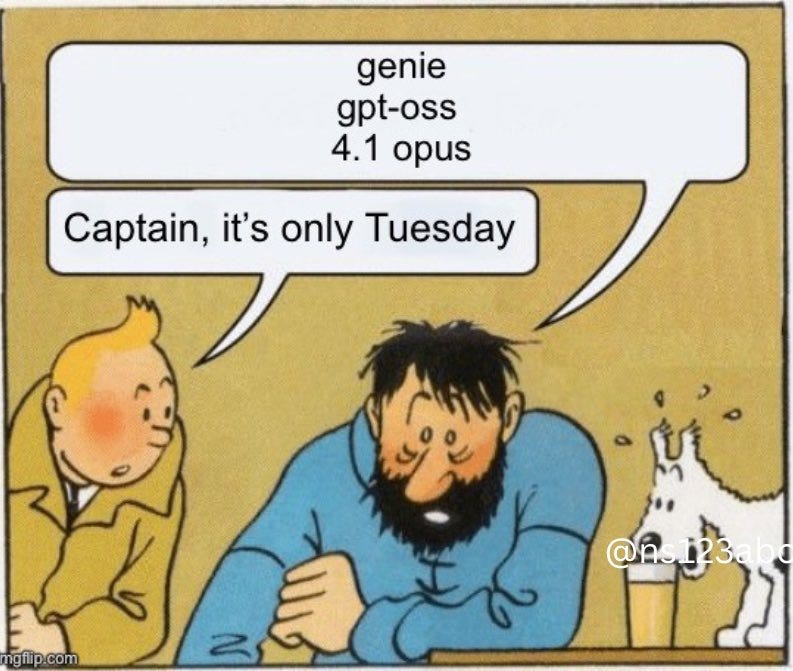AI's Day of Reckoning
OpenAI Goes Open Source, Claude Releases Its Strongest Coder, and Google's "World Model" Wows.
August 5th, 2025, will be remembered as a pivotal moment in the evolution of AI. In a span of 24 hours, the three most important AI labs in Silicon Valley—OpenAI, Google, and Anthropic—each unveiled a significant new model. This kind of "clash day" is something we haven't seen in a while.
What's different this time is that instead of a head-to-head confrontation, each company showcased a different direction for the future of AI. The narrative is shifting from a singular race for "who has the strongest model" to a more complex and multifaceted competitive landscape.
OpenAI's GPT-oss: A Strategic “Open Source” Play
OpenAI finally delivered on its long-awaited open-weight model: GPT-oss, a 13B parameter dense model. This isn’t a SOTA (State-of-the-Art) model designed to compete with GPT-4o or Claude 4.1. Its performance is comparable to Llama 3 8B or Qwen2 7B, and in some benchmarks, it even falls slightly behind its peers. Its significance, however, lies not in its performance but in the "OpenAI" name and the license attached to it.
First, let's be clear: this is not a fully open-source model.
GPT-oss uses a custom "OpenAI Model License 1.0" with a crucial "poison pill" clause. It prohibits any commercial entity with annual revenue exceeding $100 million or over one million daily active users from using GPT-oss to develop services that compete with OpenAI's core products (like the API or ChatGPT). This clause shrewdly excludes large potential rivals while simultaneously opening the door for countless small-to-medium developers and researchers to enter its ecosystem.
This move marks a major strategic shift for OpenAI, its first open-weight release since GPT-2. The company is no longer just the closed-source leader on the hill; it's using a "good enough" open model to draw developers into its orbit. The idea is for developers to build and fine-tune with GPT-oss locally, then seamlessly migrate to more powerful closed-source OpenAI models. This is a defensive and expansionary maneuver against the rise of open-source players like DeepSeek and Qwen, which have been eroding OpenAI’s developer base by offering comparable, free alternatives to its expensive closed models.
Google's Genie 3: From Generating Worlds to "Playing" in Them
While GPT-oss is a product of commercial strategy, Google’s Genie 3 is a showcase of pure technological imagination. The model redefines the overused term "world model" by moving beyond generating simple videos or 3D assets to creating fully interactive 3D worlds.
Give Genie 3 an image, a text description, or even a simple sketch, and it generates a coherent, physics-aware 3D environment that you can explore in real-time. It understands natural language commands like "walk left" or "jump" and instantly renders the corresponding first-person perspective. This is made possible by a "spatiotemporal video transformer" (SVT) architecture, trained on over 200,000 hours of public game footage (primarily 2D platformers).
Genie 3 doesn't just generate worlds; it learns the causal relationships between actions and their effects. For example, a specific tree will remain consistent across different scenes. For the first time, AI can create a virtual space you can "play" in. This represents a seismic leap forward for gaming, simulators, robotics, and the path toward a true metaverse.
The tech community's reaction was one of unanimous awe. NVIDIA's senior research scientists Jim Fan and Phillip Isola were both astounded. Isola called it "insane," while Fan described it as a "quantum leap." This AI, which can conjure an entire interactive game world from a single image by internalizing the intuitive physics of our world from countless videos, could be a critical step toward building general-purpose robots.
Anthropic's Claude 4.1 Opus: The New "God" of Programmers
Anthropic, meanwhile, doubled down on its sharpest weapon. The new Claude 4.1 Opus has a single, clear goal: to be the ultimate coding assistant.
According to official data, Claude 4.1 Opus achieved a remarkable 85.2% on the HumanEval+ benchmark, which measures code generation, debugging, and logical reasoning. This score surpasses GPT-4o’s previous record of 84.9%. In internal Agentic Coding evaluations, its problem-solving abilities nearly doubled. On top of being more capable, Claude 4.1 is also faster and more affordable, offering developers and enterprises a significant boost in efficiency and value. Anthropic continues to pursue the most pragmatic and commercially viable path—a strategy that has become a key part of its competitive moat.
The performance of these new models in real-world environments is what the industry will be watching next. We'll be conducting our own evaluations. What's clear is that this "clash day" was fundamentally different. The models weren't direct rivals; they were more like distinct, well-timed announcements designed to maximize collective attention.
This suggests that the old competitive playbook—like OpenAI rushing to release a similar model to undercut a rival—is becoming less viable. A model like GPT-5 is no longer a project with a fixed deadline but a research endeavor that requires numerous variables to mature. When your "killer app" isn't ready, strategy becomes paramount. For OpenAI, a tactical "open source" model became the necessary move to hold its ground.
More importantly, this day marked a clear division of labor among the major players:
Anthropic's Claude is establishing a "remote lead" in coding, a specialized advantage it is keen to solidify.
OpenAI, in a period of unprecedented turbulence, is focusing on building a comprehensive ecosystem to protect its still-present, but shrinking, first-mover advantage while waiting for GPT-5 to mature. This combination is designed to maintain confidence and valuation.
Google, after catching up in core LLM capabilities, is once again playing the role of paradigm-shifter. From VEO3 to Genie 3, it's investing resources that others can't or won't, betting on the next major breakthrough.
The progress hasn't stopped, and the world of AI just got a whole lot more interesting.



